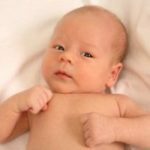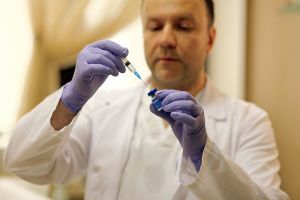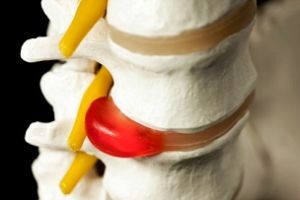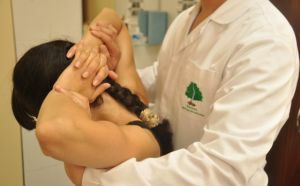
Spasmodic torticollis( G24.3) - is a painful periodical or constant spasm of the neck muscles , because of which the head turns to the side and leans forward, backwards or sideways.
It is observed in women 2 times more often.
The average age of a person suffering from this lesion is 30-60 years.
In the structure of congenital deviations, torticollis in the newborn takes 3rd place after clubfoot and hip dislocation.
Article Contents
- Causes and risk factors
- Symptoms and signs of pathology
- treatment of diseases
- Conservative treatment
- Surgery
- recommendations for infants
- treatment of diseases in adults
- Traditional medicine
- Complications of the disease
- Preventive measures
Causes and risk factors
depending on the time of appearancediseases in adults and children, there are two forms of this disorder: congenital and acquired.
Congenital spasmodic torticollis in the infants is detected at the moment of the appearance of crumbs into the light, and its main cause is the incorrect position of the baby's head in the intrauterine period.
In some cases, there is a professional deviation - the acquired torticollis in adults, provoked by pathological processes in the spine and muscles with prolonged forced position of the head when performing work duties.
The following causes and risk factors for the development of pathology are distinguished:
- genetic predisposition;
- inflammation of the nervous system;
- of neuroinfections;
- arteriosclerosis of cerebral vessels;
- intoxication;
- hepatocerebral dystrophy;
- birth injury;
- Huntington's chorea;
- brain tumors;
- cerebral palsy.
Spastic torticollis often occurs in adults. In children, the disorder is associated with changes in the structure of the sternum or clavicle of the muscle in intrauterine hypoxia.
Spastic torticollis in the baby has such reasons:
- problems with the nervous system;
- intrauterine hypoxia;
- trauma in childbirth;
- long finding of the head in one position.
Such a state can pass by itself, but not to "risk" it is better to tackle its treatment.
When the stage is started, changes in the vertebrae of the neck with skull asymmetry, neck and sternum curvature, and vision damage can be observed.
Such manifestations in adults are not observed only if the lesion is not caused by neurological problems.
 . What is characteristic of the syndrome of the carpal canal and what you need to know about this disease you can learn from our article.
. What is characteristic of the syndrome of the carpal canal and what you need to know about this disease you can learn from our article.
What is the danger of contracture of the hip joint, if not started timely and correct treatment? You can find out more details here.
Symptoms and signs of pathology
Basically, the first symptoms of torticollis are observed immediately at birth. However, if the defect is light, it may remain hidden for some time.
The main symptoms of the "adult" and infantile deviations are:
- tilt the head in one direction and turn the chin in the other;
- an increase in the sternum muscle;
- deformation of the bones of the skull and sternum;
- bone changes on the x-ray;
- decreased mobility of the head;
- skull asymmetry;
- differences in the location and shape of the ears.

With age, the manifestations of lesions in children increase, and by the age of 4 are clearly pronounced. When examining the baby front asymmetry of the neck is noticeable. In extremely rare cases, you can see a two-sided tortoise in infants.
Treatment of the disease
In cases where the cause of the abnormality is abnormal growth of bone tissue, then neutralization of the deviation can be considered quite successful.
Worse, if spastic torticollis in adults is observed due to diseases of the nervous system, then treatment is much more difficult.
Conservative treatment
Spasms with curvature can be neutralized by massage and physiotherapy. When the jaw massage, the side of the turn of the head is affected.
By medication, it is possible to neutralize the pain that causes spasms. Anticholinergic drugs blocking impulses are used, and benzodiazepines have a calming effect. The doctor may prescribe the use of antidepressants and relaxants.
The injection of a small-dose substance with the challenge of botulism makes it possible to significantly reduce pain, to provide a relatively normal head position for a couple of months.
Massage in defeat is of great importance. Most of the torticollis in infants disappears after a course of gymnastics and manual therapy. You can begin treatment activities when the baby reaches the age of two weeks.
In between sessions, the baby can develop the muscle himself. It is enough for parents to arrange on the healthy side of the baby's baby, and he, tilting and turning his head toward them, will engage in charging.
Surgical intervention
If massage and gymnastics do not work and spastic torticollis is observed in adults, doctors insist on surgical treatment.
The operation consists in cutting the legs of the clavicle muscle in the place of attachment to the clavicle, as well as in cutting the superficial fascia of the neck.
To prevent recurrence, incomplete excision of the lower parts of both legs of the muscle is carried out.
In some cases, plastic lengthening of the muscle can be performed by means of artificial materials. Basically, the operation is performed at 3 years.
Recommendations for infants

On the photo spasmodic torticollis in the child
For the treatment of torticollis newborns and infants up to a month are recommended:
- Massage with warming procedures.
- Special gymnastics for stretching and strengthening of unhealthy muscles.
- The right dream. In this case, you need to put the baby in bed correctly.
- Foam frame, collar with lining.
For treatment of infants from 1.5 months, physiotherapy with potassium iodide is prescribed, which facilitates resorption of muscle tightening.
After 2 years the child can prescribe a plaster collar for fixing the head, neck and trunk. Through the same time periods it is changed to a new one.
For more details, please read our article:

How to determine that a newborn child has a torticollis
. When curled, the main symptom is an abnormal deviation of the head to one side. Often occurs with a defect of the sternocleidomastoid. ..
Treatment of pathology in adults
For the treatment of adults, prescribe drugs that eliminate muscle spasms and reduce pain. Often these are anticholinergics and sedatives. In some cases, antidepressants and relaxants may be used.
If other methods of treatment did not help, carry out an operative removal of those nerves that innervate specific neck muscles. In cases of torticollis, psychotropic drugs are prescribed because of emotional disorders.
Traditional medicine
Treatment with folk remedies spastic krivoshe is also very popular.
Fixing weights on the shoulder from the patient side gives good results. With their help, the defect is well fixed: under the action of the load, the nodding muscle stretches and relaxes.
Small bags with sand or croup of soft cloth can be used as a load. A bag can be sewn to children's clothing in the shoulder or armpit area, but so that it does not interfere with the movement of the hands and head.
Also suitable recipes:
- Mumiye 0.2 g and 1 tsp.honey dissolve in warm water or milk, take 1 time a day in the morning for 0.5 hours before meals or in the evening before going to bed. The effect will appear in 3 months.
- Take 100 g of lilac kidney and 0.5 kg of pork fat, place in a jar and boil for 1 hour in a water bath. The received structure to rub in a sore spot 4 times a day.
- 100 g of guinea bark, 100 g of lavender, 75 g of linden flowers.
- 2 tbsp. Spoon the mixture to brew 2 tbsp.water, boil for 1 minute, stand for 2 hours. To profile. Take 100 ml four times a day for half an hour before meals.
Complications of the disease
 The negative consequences of torticollis, if left untreated, intensify depending on the time of development of the disorder.
The negative consequences of torticollis, if left untreated, intensify depending on the time of development of the disorder.
In children, lesions cause changes in the neck muscles and the degeneration of muscle tissue.
develops as a disorder of the development of the skull: the eye gap decreases, the eyebrow and ear fall, the face becomes more asymmetric with age.
Also, the disorder causes a disorder:
- of cerebral blood outflow;
- of cerebral function in adults and mental development in children;
- function of external respiration, one part of the sternum is late in development, cardiac activity due to deformity of the chest.
Preventative measures
Prevention depends on the form of the disease and the causes of the onset.
The effect of the treatment should be maintained by self-relaxation of the muscles of the neck and shoulder girdle, by the restructuring of the dynamic stereotype, by purchasing an orthopedic pillow for sleeping, and avoiding actions that promote muscle spasm in one side of the body.



